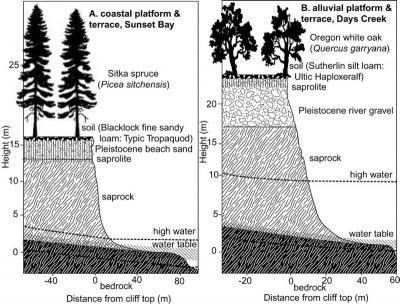Boulder, Colorado, USA – The June GSA TODAY science article is now online and open access at http://www.geosociety.org/gsatoday/. In this issue, Gregory Retallack and Joshua Roering of the University of Oregon enter the long-standing debate as to whether rock platforms along coasts and rivers are the product of physical erosion or chemical weathering above the water table.
Although the notion of wave-cut or stream-cut platforms is firmly entrenched in the literature, Retallack and Roering present the case that a more important role is played by subaerial chemical weathering. Using data from intertidal and riverside rock platforms in southwest Oregon, they show that the platforms correspond to the saprock-bedrock boundary and remain within the zone of modern water table and intertidal fluctuation despite continuing tectonic uplift. Above this zone of frequent wet/dry cycling, the rock is weakened by subaerial weathering, producing a sharp decrease in rock strength. Hence, in this case, waves and floods do not cut rock but remove clasts already weakened by weathering to expose the local water table as a bedrock surface.

This is a saprock-bedrock boundary at water table in coastal rock platform at Sunset Bay (A) and alluvial rock platform at Days Creek (B), Ore.
(Photo Credit: G. Retallack and J. Roering.)
Source: Geological Society of America